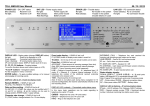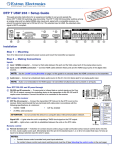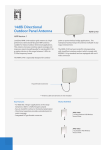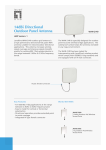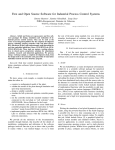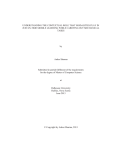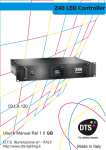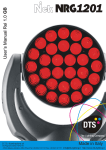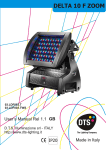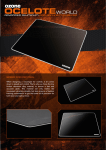Download SRG School Robotics Competition 2012
Transcript
Schools’ Robotic Competition Singapore Robotic Games 2012 SCHOOLS’ ROBOTIC COMPETITION – ROBO CAN - COLLECTOR 1. OBJECTIVE To design and build a robot that is able to start from a “Start-Box” to collect a “can” weighing 200g one at a time and then return to the starting point. During the collection trip, the robot will navigate a black path automonously and at the end of the path, it is to be navigated manually via remote-control mode to collect a piece of can placed on a rocker. During the return trip, the robot is to be navigated wirelessly and manually until the end of the path and then it will subsequently return to the starting box for unloading through path-tracing means automonously. 2. JUDGING CRITERIA The robot which has the highest points (collected “cans” – total penalty points) within the stipulated duration of FOUR minutes is the winner. 3. ENTRY REQUIREMENTS 3.1 The Robo Can–Collector is opened for all full-time students from formal MOE primary or secondary schools and equivalent for oversea participants. Student participants should not exceed the age limit of 17 year-old as of 31-Jan 2012. 3.2 Each school could submit up to three entries. Each entry shall not be more than four students and must have its own can-collection robot. No robot shall be shared by any entries and no cloning (identical design) is allowed. 3.3 Entry closes two weeks before the competition. The robot must pass inspection at the beginning of the competition. Further details are available from the official web site. 3.4 All robots and the remote controller shall be caged at the beginning of the competition and will be returned only at end of the entire competition. 4. RULES AND REQUIREMENTS 4.1 The robot is to be controlled by an on-board programmable microcontroller with power not exceeding 6 AA batteries (i.e. 6 x 1.5V = 9V or battery power not exceeding 9V). The robot should not exceed 25 cm in length and width. 4.2 Playing field design: a) As shown in Figure 1, the playing field with an approximate size of 176 by 192 cm is constructed using the proprietary brick tiles from Plegofield (www.plegofield.com) into 12 columns x 11 rows. b) The playing field which has black path (against the white background) layout for path tracing purposes is made up of modules one and two. c) Module one playing field has a start box measuring 25 cm by 25 cm and an unknown black path design. The black path will be a single track with no cross junctions leading to module 2. The start box will be constructed from 6 brick tiles as follows. It is where the robot will start and finish and it can be located any where within module one and in any orientation (i.e. facing any direction). START BOX 25 x 25 cm 46 26 September 2011 Schools’ Robotic Competition Singapore Robotic Games 2012 d) As shown in Figure 1, module two of the playing field is meant for user’s manual remote control. As soon as the robot enters the obstacle zone on rocky terrain (Figure 2), handler can then activate the remote controller to navigate the robot to collect one piece of can. The obstacle zone has width equivalent to five brick tiles is contructed by loading marbles onto the inverted brick tiles. One piece of can will be pre-loaded on one of the five rocker arms (Figure 3). e) The tiles that make up module two need not to be in plain colors as plain color tiles are limited in the Plegofield set. Tiles of any print can be used in the construction of module two as remote control mode that takes place in this module will be independent of the printed lines on the tiles. 47 26 September 2011 Schools’ Robotic Competition Singapore Robotic Games 2012 Rocky Terrain as constructed from marbles Figure 2 (right) Rocker Arm Front View Rocker Arm Back View Figure 3: The Rocker Arm f) Other than the rocky-terrain obstacles, other types of obstacles include: • Obstacles created by removing the brick tiles, • Cylindrical obstacles to be placed randomly by the judges just before competition commences to prevent robot from taking “short cut” to reach the “can”, • Obstacle plates are placed in module 2 in random order and position. 4.3 Both the robot and the remote controller will be caged at the beginning of the event. A printout of the transmitting program must be submitted at the time of caging. For different teams from the same school, the same remote controller can be used. However this must be made known at the time of caging with the team names stated in the printout. 4.4 Each team will provide a robot and a remote controller. The robot will be placed manually at the start box of module 1 playing field. When competition commences, handler will press a swtich to commence the path-tracing routine. One 200g “can” will then be placed on one of rocker when the robot reaches end of module one (i.e. enters the rocky terrain). At this time, the handler can drive the robot wirelessly via the remote controller to collect the can from the required can’s position. The handler is not allowed to touch the remote controller before the robot hits the rocky terrain. A penalty of 1 points (1 point penalty is equivalent to one can collected) will be given if the handler started the remote control too soon. 48 26 September 2011 Schools’ Robotic Competition Singapore Robotic Games 2012 4.5 Like wise, on the return trip, the remote control portion will end as soon as the robot reaches the rocky terrain. After that, the robot will move in an automononus manner via the black path to return to the Start Box. The “can” is said to be successfully delivered when any part of the robot body touches the starting box outline. Upon reaching the finishing position, the handler will unload the “can” and at the time reposition the robot within the starting box to commence the following run to collect the next “can”. The remote controller could be reset if needed. Only one “can” is to be collected for each run. Only one handler is allowed to assist the robot at the starting and finishing position and another handler to operate the remote controller. 49 26 September 2011 Schools’ Robotic Competition Singapore Robotic Games 2012 4.6 It is considered an “aborted run” should the robot drop its “can” on the field in the course of its run. The robot is to start from the starting position and a “can” will be placed on any rocker arms by the judge. 4.7 The robot is given four minutes to collect as many “cans” as possible. 4.8 No adjustment is allowed in the open field during the run. The robot must be brought back to the starting box and restart when being inactive, disabled, stucked or out of control in the open field. This will be considered as one aborted run, and the decision to abort the run is at the discretion of the handler. Permission may be granted for 1 recess (10 minutes) and it carries a penalty of 2 minutes on the competition time. 4.9 In the event of a tie, the robot that collects a “can” in its very first run and with the shortest time will be ranked highest. If there is still a tie, the robot with the least number of aborted runs during the game will be ranked next. On further tie, the rank will be determined by either the shortest time for a successful collection of a “can” or the furthest distance covered for a non-delivery, of ONE final run. FAQ (Frequently Asked Questions) 1. Must we use only Lego parts. Can we use parts from other sources? There is no restriction on parts used. 2. How many motors are allowed? No limits on number of motors used. However, you are limited in the use of maximum 9 V (6 x 1.5V) battery source. 3. How many sensors are allowed? No restriction on number of sensors used. 4. Are we allowed to use other microprocessors beside the RCX and other type of sensors supplied with Lego Mindstorm? There are no restrictions microprocessor and sensors used. 5. Are we allowed to use other remote controllers besides the NXT? You can use RC controller with appropriate frequencies. For NXT users, you can configure another NXT controllers to communicate with robot controller via Bluetooth. 6. Can my robot collect more than one can at a time? No, robot can only collect one can at one time. 7. What brand is the can drink? We use Jia Jia Herbal Tea cans. 8. What is filled inside the can to make its weight 200g? Beans or rice. 9. Will there be a practice run? Due to constrain in the venue, we could only set up the track on the actual day. We might consider allowing practice time one to two hours before event commences. 10. Are we allowed to measure the light sensor values so that we can program it on our robot before caging? Please do so during practice runs, usually few hours before the event. 11. What does caging mean? Only particpating robots and transmitter controller need to be caged in a common area before the start of competition. Caged robot will only be released back to the students until the end of the whole competition. 12. Can I take back my robot if I know I have no chance of winning any medal? Usually you are not allowed to take back your robot till the end of the competition. However, we understand that some school need to leave early as the bus is waiting etc. In that case, we allow early return of robots provided all the teams from the same school have completed their runs and are out of contention for any medals. 50 26 September 2011 Schools’ Robotic Competition Singapore Robotic Games 2012 13. Must the entire robot start behind the starting line or can some parts of the robot be in front of the line such as the light sensor? The entire robot including sensors, arm etc need to be behind the starting red line. 14. Must the robot follow the line strictly. Can we just program the robot to go straight without following the line. Robot must follow the line to reach the end of the path as there are obstacle placed randomly everywhere and robot will not be able to take any short-cut. 15. Is flash photography allowed during the runs?. Flash is not allowed as flash might affect the light sensors. 16. Are we allowed to wipe the playing field with a dry cloth before starting the run? Yes, but please inform the judges first to get his/her permission. 17. What kind of message is sent by the broadcasting controller? Participants decide their own protocol. 18. Where is the remote controller positioned? The remote controller is to be held by a handler standling directly opposite the handler managing the robot, when it is in use, otherwise it will be placed on the table to ensure that user does not operate it. 19. Who will be responsible to operate the remote controller? How could you ensure that message is sent at the right time? A team member will operate the remote controller. The judge or the event organizer will place the can on the rocker after the robot is on manual control in wieless mode. The picture shows the remote controller location and the robot location when the can position is made known. 51 26 September 2011







